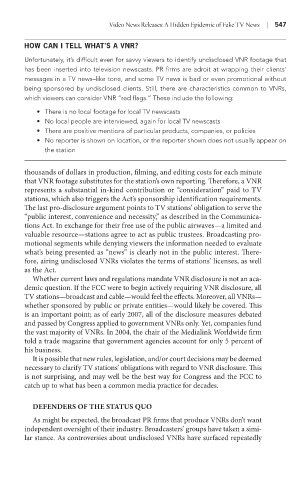Page 568 - Battleground The Media Volume 1 and 2
P. 568
V deo News Releases: A H dden Ep dem c of Fake TV News |
how Can i tell what’s a Vnr?
Unfortunately, it’s difficult even for savvy viewers to identify undisclosed VNR footage that
has been inserted into television newscasts. PR firms are adroit at wrapping their clients’
messages in a TV news–like tone, and some TV news is bad or even promotional without
being sponsored by undisclosed clients. Still, there are characteristics common to VNRs,
which viewers can consider VNR “red flags.” These include the following:
• There is no local footage for local TV newscasts
• No local people are interviewed, again for local TV newscasts
• There are positive mentions of particular products, companies, or policies
• No reporter is shown on location, or the reporter shown does not usually appear on
the station
thousands of dollars in production, filming, and editing costs for each minute
that VNR footage substitutes for the station’s own reporting. Therefore, a VNR
represents a substantial in-kind contribution or “consideration” paid to TV
stations, which also triggers the Act’s sponsorship identification requirements.
The last pro-disclosure argument points to TV stations’ obligation to serve the
“public interest, convenience and necessity,” as described in the Communica-
tions Act. In exchange for their free use of the public airwaves—a limited and
valuable resource—stations agree to act as public trustees. Broadcasting pro-
motional segments while denying viewers the information needed to evaluate
what’s being presented as “news” is clearly not in the public interest. There-
fore, airing undisclosed VNRs violates the terms of stations’ licenses, as well
as the Act.
Whether current laws and regulations mandate VNR disclosure is not an aca-
demic question. If the FCC were to begin actively requiring VNR disclosure, all
TV stations—broadcast and cable—would feel the effects. Moreover, all VNRs—
whether sponsored by public or private entities—would likely be covered. This
is an important point; as of early 2007, all of the disclosure measures debated
and passed by Congress applied to government VNRs only. Yet, companies fund
the vast majority of VNRs. In 2004, the chair of the Medialink Worldwide firm
told a trade magazine that government agencies account for only 5 percent of
his business.
It is possible that new rules, legislation, and/or court decisions may be deemed
necessary to clarify TV stations’ obligations with regard to VNR disclosure. This
is not surprising, and may well be the best way for Congress and the FCC to
catch up to what has been a common media practice for decades.
DEFEnDErs oF ThE sTaTus quo
As might be expected, the broadcast PR firms that produce VNRs don’t want
independent oversight of their industry. Broadcasters’ groups have taken a simi-
lar stance. As controversies about undisclosed VNRs have surfaced repeatedly

